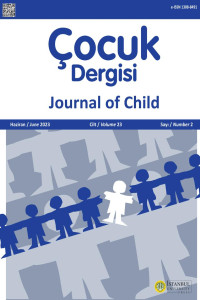Öz
Trikorhinofalangeal sendrom, TRPS1 genindeki mutasyonların neden olduğu nadir bir hastalıktır. Hastalık, koni şeklindeki epifiz ve brakidaktiliyi içeren iskelet malformasyonları ve yavaş büyüyen saç ve tırnak ile karakterizedir. Kalça problemleri sıklıkla gözlenir ve hipermobiliteye bağlı kasiskelet ağrıları da ortaya çıkabilir. Bu nadir hastalıkla ilişkili dismorfik özelliklerin tanınması, bu hastaların hızlı teşhis edilmesini ve daha iyi izlenmesini sağlayabilir. Burada uzun süredir şikayetleri olan ve trikorinofalangeal sendrom tanısı alan bir pediatrik olguyu sunuyoruz.
Anahtar Kelimeler
Kaynakça
- Bird HA. Joint hypermobility. Musculoskeletal Care 2007;5(1):4-19. google scholar
- Maas SM, Shaw AC, Bikker H, Lüdecke HJ, van der Tuin K, Badura-Stronka M, et al. Phenotype and genotype in 103 patients with tricho-rhino-phalangeal syndrome. Eur J Med Genet 2015;58(5):279-92. google scholar
- Candamourty R, Venkatachalam S, Karthikeyan B, Babu MR. Trichorhinophalangeal syndrome type 1: A case report with literature review. J Nat Sci Biol Med 2012;3(2):209-11. google scholar
- Lüdecke HJ, Schaper J, Meinecke P, Momeni P, Gross S, von Holtum D, et al. Genotypic and phenotypic spectrum in tricho-rhino-phalangeal syndrome types I and III. Am J Hum Genet 2001;68(1):81-91. google scholar
- Momeni P, Glöckner G, Schmidt O, von Holtum D, Albrecht B, Gillessen-Kaesbach G, et al. Mutations in a new gene, encoding a zinc-finger protein, cause tricho-rhino-phalangeal syndrome type I. Nat Genet 2000;24(1):71-4. google scholar
- Gai Z, Gui T, Muragaki Y. The function of TRPS1 in the development and differentiation of bone, kidney, and hair follicles. Histol Histopathol 2011;26(7):915-21. google scholar
- Forys-Dworniczak E, Zajdel-Cwynar O, Kalina-Faska B, Matecka-Tendera E, Matusik P. Trichorhinophalangeal syndrome as a diagnostic and therapeutic challenge for paediatric endocrinologists. Pediatr Endocrinol Diabetes Metab 2019;25(1):41-7. google scholar
- Stagi S, Bindi G, Galluzzi F, Lapi E, Salti R, Chiarelli F. Partial growth hormone deficiency and changed bone quality and mass in type I trichorhinophalangeal syndrome. Am J Med Genet A 2008;146A(12):1598-604. google scholar
- Howell CJ, Wynne-Davies R. The tricho-rhino-phalangeal syndrome. A report of 14 cases in 7 kindreds. J Bone Joint Surg Br 1986; 68: 311-4. google scholar
Öz
Trichorhinophalangeal syndrome is a rare disease caused by variations in the TRPS1 gene. The disease is characterized by slowly growing hair/nail and skeletal malformations, including brachydactyly and cone-shaped epiphysis. Hip problems are frequently observed, and musculoskeletal pain associated with hypermobility may also occur. Recognition of dysmorphic features associated with this rare disease may lead to prompt diagnosis and improved care of these patients. Herein, we present a paediatric case with longstanding complaints diagnosed with the trichorhinophalangeal syndrome.
Anahtar Kelimeler
Brachydactyly Cone-Shaped Epiphysis Hypermobility Legg-Calve-Perthes Mitral Valve Prolapse Trichorhinophalangeal Syndrome
Kaynakça
- Bird HA. Joint hypermobility. Musculoskeletal Care 2007;5(1):4-19. google scholar
- Maas SM, Shaw AC, Bikker H, Lüdecke HJ, van der Tuin K, Badura-Stronka M, et al. Phenotype and genotype in 103 patients with tricho-rhino-phalangeal syndrome. Eur J Med Genet 2015;58(5):279-92. google scholar
- Candamourty R, Venkatachalam S, Karthikeyan B, Babu MR. Trichorhinophalangeal syndrome type 1: A case report with literature review. J Nat Sci Biol Med 2012;3(2):209-11. google scholar
- Lüdecke HJ, Schaper J, Meinecke P, Momeni P, Gross S, von Holtum D, et al. Genotypic and phenotypic spectrum in tricho-rhino-phalangeal syndrome types I and III. Am J Hum Genet 2001;68(1):81-91. google scholar
- Momeni P, Glöckner G, Schmidt O, von Holtum D, Albrecht B, Gillessen-Kaesbach G, et al. Mutations in a new gene, encoding a zinc-finger protein, cause tricho-rhino-phalangeal syndrome type I. Nat Genet 2000;24(1):71-4. google scholar
- Gai Z, Gui T, Muragaki Y. The function of TRPS1 in the development and differentiation of bone, kidney, and hair follicles. Histol Histopathol 2011;26(7):915-21. google scholar
- Forys-Dworniczak E, Zajdel-Cwynar O, Kalina-Faska B, Matecka-Tendera E, Matusik P. Trichorhinophalangeal syndrome as a diagnostic and therapeutic challenge for paediatric endocrinologists. Pediatr Endocrinol Diabetes Metab 2019;25(1):41-7. google scholar
- Stagi S, Bindi G, Galluzzi F, Lapi E, Salti R, Chiarelli F. Partial growth hormone deficiency and changed bone quality and mass in type I trichorhinophalangeal syndrome. Am J Med Genet A 2008;146A(12):1598-604. google scholar
- Howell CJ, Wynne-Davies R. The tricho-rhino-phalangeal syndrome. A report of 14 cases in 7 kindreds. J Bone Joint Surg Br 1986; 68: 311-4. google scholar
Ayrıntılar
| Birincil Dil | İngilizce |
|---|---|
| Konular | Çocuk Sağlığı ve Hastalıkları |
| Bölüm | Olgu Sunumu |
| Yazarlar | |
| Yayımlanma Tarihi | 30 Haziran 2023 |
| Yayımlandığı Sayı | Yıl 2023 Cilt: 23 Sayı: 2 |


